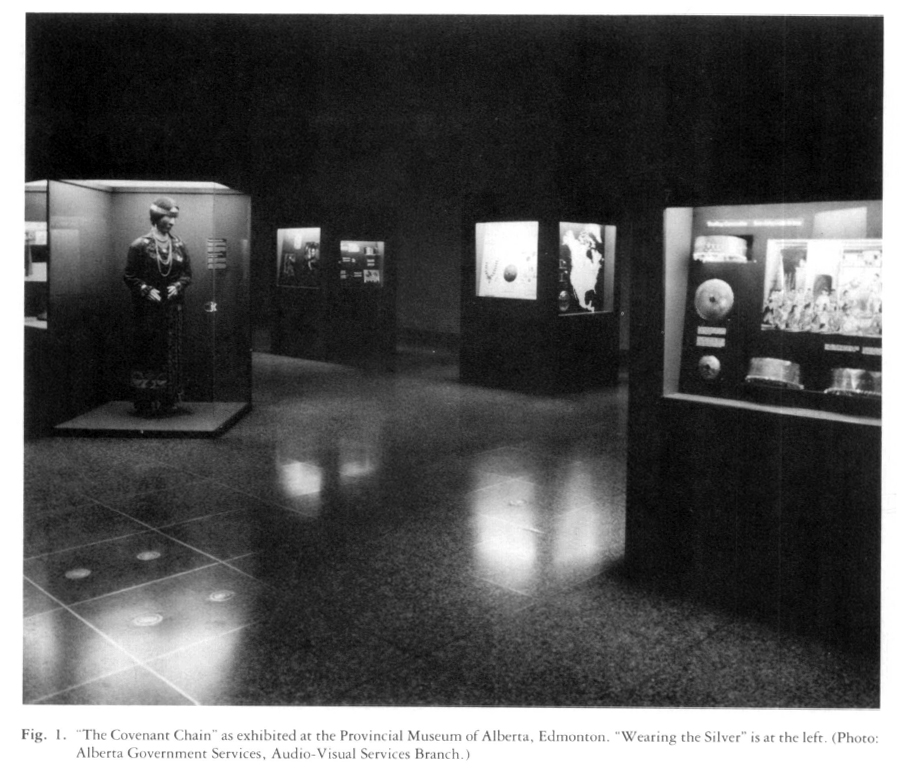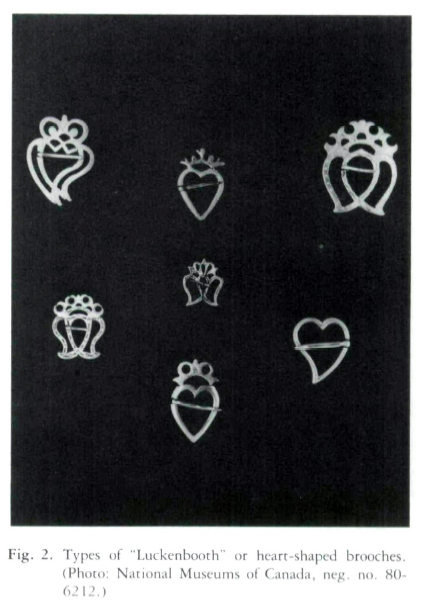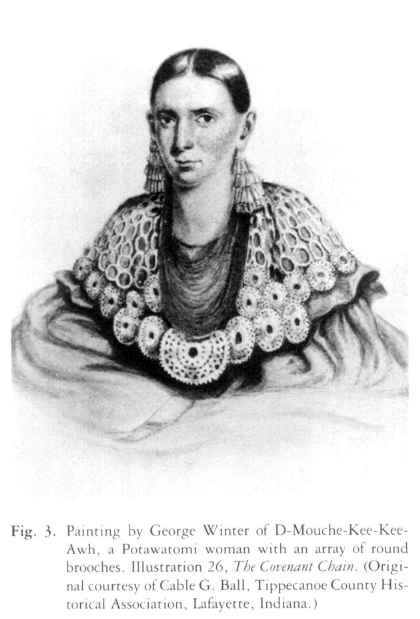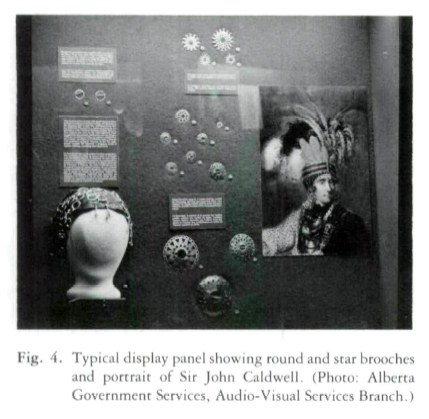Reviews / Comptes rendus
National Museum of Man, "The Covenant Chain: Indian Ceremonial and Trade Silver"
 Display large image of Figure 1
Display large image of Figure 11 Nearly every museum collection in Canada and the northern United States has some trade silver, Sandra Gibb observed when she came to Edmonton with the National Museum of Man's "Covenant Chain" exhibit. It is greatly to her credit, and that of her co-workers, that so much of this dispersed and relatively little-known silver, of such variety and quality, was brought together from twenty collections in Canada, the United States, and Scotland.
2 Over 350 pieces are presented in the exhibit, primarily in nine four-sided black modules, each measuring four feet in width. Graphics are generally mounted on open, inset, slanted, and top-lit panels; artifacts arc on similar glass-covered panels or in small attached boxes. A single deep case with three glass sides, a large centre-piece module combining high rectangular with triangular compartments, and a large plexiglass cube with opaque corner extensions complete the exhibit furniture. At the Provincial Museum of Alberta, all but the last of these modules were displayed within a sunken gallery, having a slightly insufficient area of about two thousand square feet (fig. 1).
3 The exhibit and the accompanying catalogue have been thoroughly researched by Jaye Fredrickson. Both are generally well organized and profusely and appropriately illustrated with artifacts and reproductions of paintings or drawings. On analysis, the exhibit may be seen to follow three related thematic lines:
- The evolution of Indian ceremonial and trade silver from the late 1600s to the early 1800s.
- The primary forms of trade silver through the period: (a) medals, which were adapted, modified, or specially struck; (b) other forms adapted from European prototypes; (c) forms of generally universal character; (d) native-inspired forms, or "stock" items modified by or for Indians.
- the functions of trade silver, illustrated primarily by approximately thirty of the graphics and two mannequins.
4 These themes are set within a story-line beginning when growing European-Indian trade, military, and political alliances were supported by gifts of medals and characterized by the symbolic linking of cultures with a silver "chain of friendship." "Out of diplomatic exchanges grew the fur trade that so profoundly affected North American native life." In the same process there developed the large, competitive trading companies and the "trading ceremony," with its reliance on rich manufactured silver offerings such as armbands, legbands, hatbands, gorgets, and medals. Spectacular examples of all these are included in the exhibit. Such goods were presented to the principal chiefs and others of lesser rank with a protocol closely patterned on native gift giving, pledging, and council ceremony, symbolized among the Iroquois by the wampum belt. (Notably, one of the two wampum belts on display depicts the covenant chain linking an Indian and a white man.)
5 An important transitional panel (which may unfortunately be lost to some viewers because it occurs unexpectedly on the back of the deep case) records the development of silver as a trade good with the enormous increase in quantity of "trinkets" and the growth of relatively standard values. The distribution of trade silver through barter and population movement is graphically portrayed on a map with accompanying artifacts, showing, for exam pie, the archaeological occurrence of Montreal-made goods as far away as Alberta and Alabama.
6 At this point in the exhibit, the manufactures of a half-dozen Montreal or Quebec silversmiths are highlighted, and their touch-marks are characterized. Trade silver of British or American manufacture is given much less attention. General methods of manufacture are shown, ranging from the simpler use of individually pounded-out Spanish coins to more sophisticated techniques employing thin sheets of silver.
7 An aside to this discussion of manufacture, and treated only briefly without illustration in the catalogue, is the subject of trade silver reproductions and "fakes." This is a matter of particular interest to museum professionals and is perhaps worthy of a special exhibition or publication, with emphasis on criteria for discrimination. The discussion in this part of the exhibit suggest, for example, that no cast items (beaver, turtles, etc.) can be attributed to Canadian makers during the peak period of the fur trade through either archaeology or historical documentation.
8 The values of various items are illustrated through lists and by the particular example of a gorget selling for twenty-six shillings or three beaver pelts. I thought this example might have been strengthened if it had been juxtaposed more closely with the lists of goods, or if these early trade values had been translated into approximate present-day buying power.
 Display large image of Figure 2
Display large image of Figure 2 Display large image of Figure 3
Display large image of Figure 39 The panels that follow depict specific silver artifacts within the category forms, suggested above. Many items were adapted from European prototypes, sometimes with drastically changed meanings and uses. For example, although the gorget (itself derived from functional European armour) may have retained something of its symbolic-military character as a presentation piece, the cross became secularized and was often worn on earrings or necklaces. Of particular interest is a large Latin cross to which has been added the engraved figure of an Indian drinking from what is clearly a liquor bottle. (Gibb, however, suggested that this might not necessarily represent a secularization or a paradox, but rather the Indian owner's perception of two equally viable routes to mystical experience!)
10 Other adaptations are the more familiar profusion of types derived from the Scottish "Luckenbooth," love-token brooch (fig. 2), and from the Masonic "jewel." Again there is adaptation and the substitution of meanings; Fredrickson suggested, for example, that the double-heart Luckenbooth represented courage to the Iroquois.
11 There is no clear distinction in the labels or the audiotour of what might be characterized as universal forms such as the round or the star brooch. Possibly, it is suggested, the larger round forms may have evolved from early medals. However, Gibb's discussion of the exhibit indicated that a separable category could exist here.
12 Indian-inspired designs include armbands, ear and nose rings copied from bone and shell ornaments, and ear-wheels, along with a variety of engraved crests, frequently animal forms, some of which may have been specially ordered. In this regard the catalogue makes a suggestion here that might have been more explicit in the exhibit. There may be a significant convergence in some cases of European and Indian prototypes (military gorgets and Indian shell-disc ornaments are examples), a mutual reinforcement that afforded a particular symbolic strength and persistence to certain trade silver forms.
13 Function is perceived through contemporary paintings or drawings, generally ranging in date from the mid-1700s to the mid-1800s. The predominate insight, conveyed with far more impact than could be achieved with lists or enumerations, is the profusion in which trade-silver ornaments were produced, obtained, and worn. Contrary to our own practice of highlighting with jewellery, these paintings show the upper clothing of men and women entirely covered with brooches of repeated or varying forms (fig. 3). Earrings are worn in different combinations along much of the ear. Gorgers, always singular in traditional military use, are worn in multiples of up to six.
14 In two paintings, what I had thought of as earrings when found archaeologically are shown worn in the nose. One of these is the portrait of Sir John Caldwell, a British officer, decked out in the native finery he acquired in North America (fig. 4). Similar earrings also appear on the edge of Sir John's head-scarf, a reproduction of which is in the exhibit.
15 Formal and functional perspectives culminate in the striking centre-piece entitled "Wearing the Silvet" (fig. 1). Male and female mannequins are dressed in late eighteenth-century styles of the Great Lakes region which are based in part on Caldwell's costume. Their adornments show less profusion but perhaps even greater diversity than has previously been suggested. This centre-piece also exhibits a massive cradleboard cover, presented as the largest known piece of trade silver (fig. 5).
16 Although the barter of trade silver essentially stopped in 1821 with the end of intensive trade competition, its evolution did not. The Iroquois developed their own industry, which lasted until the 1900s and supplanted even the memory of non-Indian manufacture. Unfortunately, none of this nineteenth-century native-made silver can be identified in the exhibit. However, a recent revival of Iroquois silversmirhing in southern Ontario is well represented in the final module of the display.
 Display large image of Figure 4
Display large image of Figure 417 To supplement the exhibit at the Provincial Museum, Arthur Powless of the Six Nations Reserve demonstrated the ongoing silversmirhing tradition, bringing to life the contemporary exhibit and providing a small comparative collection for Alberta. In addition, a case of local silver objects was added, consisting largely of items obtained archaeologically and dated between about 1785 and 1820.
18 The creators of "The Covenant Chain" have set out to convey a large amount of data relating to the unfamiliar history and nature of trade silver over more than a hundred years. By and large they have been successful, selecting their examples for beauty, balance, and historical significance. As an archaeologist, I was particularly conscious of one omission. Although it is discussed at some length in the audiotour and the catalogue, little reference is made in the exhibit itself to how the bulk of this silver has been preserved - to its recovery in an archaeological context or its more frequent unsystematic discovery by individuals. An illustration of the spectacular Ojibwa Red Deer River burial could have been provided, which would show nor only something of archaeological method but also a different aspect of "wearing the silver," complementing the discussion of ornamented cradles!
19 I noted a few apparent errors of fact or implication. A trading fair in a painting appears to be taking place in 1915 (perhaps the date of the painting). The Hudson's Bay Company and North West Company trade did not end at the Rocky Mountains, as one label may imply. A daguerreotype of Chief Oshawana is dated 1836, the year before the first exposure is known to have been produced by Daguerre. The legend on one map appears incomplete and the dates are confusing. On one panel, the basis for distinction of nose ornaments and earrings is unclear. A colleague suggested there is also a confusion in the distinction of armbands and legbands. Another viewer complained of the failure to define when an unfamiliar term such as "gorget" is first used.
20 The initial impact of the exhibit is on the whole pleasing, although it is not enhanced by the variability in height and alignment of panels within the modules. Colours are generally well chosen and display units are of appropriate size and form. The beginning is slightly confusing, however. The viewer may not know where to start and in which direction to proceed, although this may have been a result of the size and shape of the largest feature gallery at the Provincial Museum. The four-sided modules are provided with large numbers keyed to the audiotour but generally on only one or two sides, and this may also be a source of confusion.
21 Labels are well written but are generous in quantity and length, and may overwhelm the silver. The next is particularly long in the section on historical background and the medallic Tradition, where the viewers should be drawn quickly into the exhibit and their attention sustained. Here and throughout I think that headlining and blocking out of the exhibit might have been stronger. The specialist or the viewer who is willing to spend several hours with the catalogue and the audiotour will have little difficulty, but a major exhibit of this quality and expense should have some basic information for everyone, even the visitor with only five minutes to spend. The useful audiotour, approximately forty minutes long, found virtually no demand at the Provincial Museum, perhaps in part because of the volume of text.
 Display large image of Figure 5
Display large image of Figure 522 Lighting and the variably coloured backgrounds are not completely successful. Dark backgrounds bring out the quality of the silver but also maximize reflection. Top-lighting does not always reach the lower artifacts, particularly when they are in the shadow of other objects or plastic fittings, or when the panels are tilted too much or not enough. A number of key surface details are lost, such as the designs on gorgets (usually pointing slightly downwards).
23 Some organization of labels and artifacts, notably in the medal section, appears busy and occasionally even sloppy. Several of the plastic mountings are obtrusive; shelves could perhaps have been shaped more nearly to the objects they support. Some items, notably the gorget's-worth of English coins, are mounted too low. The paintings and drawings are well selected and distributed, with the possible exception of an overbalance of two-dimensional illustration following the section on medals. When the exhibit arrived at the Provincial Museum, however, several graphics were apparently beginning to fade.
24 The catalogue is generally informative and well illustrated. However, it is occasionally difficult to correlate specific text or artifact illustrations with the exhibit, notably the unnumbered specimens on the mannequins. Also, it would have been nice to know the provenance of discovery of certain key artifacts such as the ornaments from the Red Deer River burial or from Rocky Mountain House. Such information can sometimes be inferred from catalogue numbers or hints within the exhibit, but it generally requires specialized foreknowledge. Also, some items in the exhibit are not included in the catalogue.
25 Travelling exhibits must perhaps be judged by somewhat different standards than those applied to the permanent display. We must appreciate the compromises necessitated by the watchful eye of the conservator, the stipulations of lenders, and the eccentricities of diverse gallery spaces. Over several years the National Museum of Man's travelling exhibits have revealed marvellous things. But there have also been some lapses in design standards and in the concern for communication with the widely varying public that these displays serve. However, "The Covenant Chain" is one of a series of memorable ethnographic and historical exhibits, produced or funded by the National Museum of Man, that have progressively conveyed the richness and variety of Canadian material culture.
"The Covenant Chain": the naming of an exhibition.
26 Since the exhibition of Indian ceremonial and trade silver first opened in Ottawa in September 1980, there have been many questions and comments about its content, theme, and presentation. The most common question, however, is, Why "The Covenant Chain"? Each time it is asked, I recall the debates that went on within the museum about the proposed title. It was too sombre. It had too many legal and religious connotations. It was not "catchy." It was too hard to pronounce. It did not explain the show adequately. But it remained "The Covenant Chain" because that title best captured the theme that underlay the show.
27 The idea for an exhibit of Indian trade silver was first proposed in the early 1970s, and I was contracted to prepare a proposal for the show in 1973- At that time, I was typical of most Canadians having never heard of trade silver. The research into it was not unlike a detective's investigation. There were pieces of silver in public and private collections across North America, and there were numerous theories to explain its existence.
28 Our key objective in preparing the exhibition was to ensure that the silver be understood in the context of its use. We wanted to avoid showing the pieces in the isolated splendor so popular for most precious metal objects. The silver itself was unusual in appearance, but as long as it was a luxurious curiosity or "just another fur trade artifact," I doubted that it would make a valuable contribution to our understanding of either the Europeans who made it or the Indians who received it.
29 Then I read Sir William Johnson's account of the silver chain that was "strengthened and brightened" almost every year in a ceremonial exchange of gifts and good will. Among those gifts were the beautiful armbands and gorgets. Here was the symbolic significance which set silver apart from other trade goods, yet gave silver a place in the cultures that made and used it. Here was "The Covenant Chain."
30 The exhibition only begins to explore the relationship between ceremony and alliance, between "trade and peace." But in so doing it opens up a dimension of the fur trade not yet commonly understood in popular history. It brings attention to the Indian traditions and influences which shaped the fur trade. If "The Covenant Chain" exhibition does no more than increase public awareness of the cultural context in which trade silver played a brief but conspicuous part, it will have accomplished its goal.
"The Covenant Chain: Indian Ceremonial and Trade Silver"
31 This exhibition originated where all museum exhibitions should - with the objects themselves. Rather than starting with a story-line and trying to illustrate it the way one would a book, we began with the artifacts and tried to depict the context in which they existed. In so doing we were able to illustrate various aspects of life in eighteenth-and nineteenth-century North America, including the fur trade, colonial wars, Indian dress styles, colonial silversmithing, and Indian-white relations. Because trade silver is made today, we were also able to give it a contemporary setting. Thus we could explore a number of themes while holding on to a continuing thread, the trade silver itself.
32 Although the collection of the National Museum of Man was the basis of the exhibition, we drew on more than twenty other collections, both public and private, to give greater variety. The research involved in ferreting out pieces in other collections was largely based on work done by Arthur Woodward before World War Ⅱ, but in our search we discovered previously untapped sources of trade silver. The lists now available will be useful to future researchers. Nearly every collection in North America has a few pieces of trade silver; it is therefore a part of our material heritage that, although hitherto relatively unknown, has had an interest for many museum curators.
33 A great deal of effort was made to display the objects in a way that would both put them in their context and show them to their best advantage. Security was an important consideration because the objects are small and portable. It was decided that the viewing surface should be close to the visitor but that the cases themselves should be large and not easily opened. To reduce the handling of the silver (thus protecting it from tarnishing), most of the pieces were mounted on the exhibition panels. The materials in the case were carefully selected and all the cases were lined with Pacific silver cloth as a tarnish inhibitor to reduce further the presence of sulphur which could affect the pieces. Subject to individual institutions' restrictions, all the silver was cleaned by a conservator and coated with Incralac, a substance used to prevent tarnish.
34 One disappointment in the installation of the objects was the unfortunate angle of the gorgets. Although they have been mounted in a secure way, the beautiful engravings on many of them are difficult to see because they face downward, and the cases are not deep enough to allow them to be mounted on a shelf, thus changing the angle of display.
35 I think the National Museum of Man can be proud of this exhibition because it accomplishes what museum exhibitions should: it shows artifacts, placing them in a context that allows the visitor to understand a little-known part of our heritage. The exhibition has been built to ensure the safety of the artifacts and their proper care both on display and in transit. Finally, it is an exhibition that is visually attractive so that visitors want to look at it. To me, these are the most important aspects of any museum exhibition.
*Reviewed during its exhibit at the Provincial Museum of Alberta, Edmonton, 15 September to 15 November 1981. A concurrent lecture and demonstration series was arranged by Trudy Nicks, Curator of Ethnology. Lectures by Sandra Gibb and N. Jaye Fredrickson wire of particular interest.